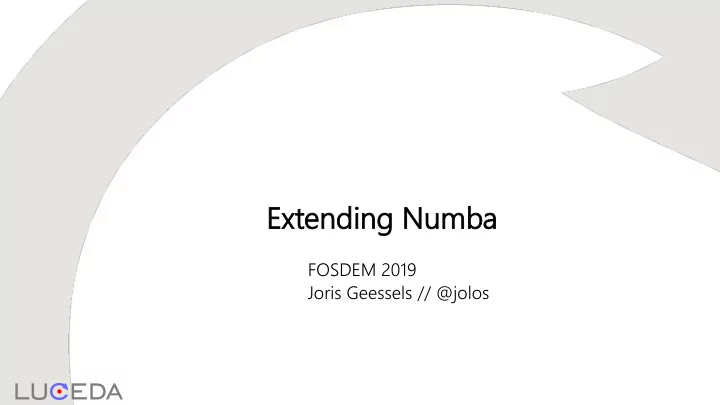

Ex Exten endi ding ng Num umba FOSDEM 2019 Joris Geessels // @jolos
JIT – compiler (LLVM) @numba.jit(nopython=True) def go_fast(a): trace = 0 accelerates Python for i in range(a.shape[0]): trace += numpy.tanh(a[i, i]) numpy support ++ return a + trace x = numpy.arange(100).reshape(10, 10) print(go_fast(x)) 2
Si Simu mula latio tion n of a PI PIC class WaveguideModel(CompactModel): Called by simulator? C++ objects? def calculate_smatrix(params, env, S): phase = 2 * np.pi / env.wavelength * params.n_eff * params.length A = 0.99 S['in', 'out'] = S['out', 'in'] = A * np.exp(1j * phase) dict support? 3
Num umba Co Comp mpile iler Pip ipel elin ine ③ add datamodels ① custom rewrite ④ custom codegen Bytecode Rewrite Type Rewrite Lowering → IR Inference (+ types) (codegen) Numba IR ② add types + inference 4
① Num umba IR IR R Rew ewrit ite from numba import ir from numba.rewrites import Rewrite, register_rewrite # 'before-inference' or 'after-inference' @register_rewrite('before-inference') class MyRewrite(Rewrite): def match(self, func_ir, block, typemap, calltypes): # search for expressions to rewrite, # return True when match return True def apply(self): # return a new function 'block’ return new_block 5
② Type pe In Infer erence ence # 2 public decorators to register your custom typers from numba.extending import type_callable, typeof_impl class MyPointType(numba.types.Type): # A custom type to represent a point # used during inference def __init__(self): super(MyPointType, self).__init__(name='Point') @type_callable(MyPoint) def type_MyPoint(context): def typer(x, y): instantiate & return # your_func returns a point your custom type return MyPointType() return typer 6
③ Lower erin ing g Type pes Lowering = generating LLVM intermediate representation (IR) from numba.extending import register_model, models @register_model(MyPointType) class MyPointModel(models.StructModel): def __init__(self, dmm, fe_type): members = [ ('x', types.int64), Data Layout ('y', types.int64), ] models.StructModel.__init__(self, dmm, fe_type, members) 7
④ Lower erin ing g calla llable bles, , se setattr tr, , ge getattr tr , … from numba.extending import lower_builtin from numba import cgutils # llvm codegen utils @lower_builtin(MyPoint, types.Integer, types.Integer) def impl_point(context, builder, sig, args): typ = sig.return_type Types of arguments assert isinstance(typ, MyPointType) x, y = args point = cgutils.create_struct_proxy(typ)(context, builder) point.x = x point.y = y return point._getvalue() Codegen utilities for StructModel 8
In Integ egratio ation n wi with C/ h C/C+ C++ import numpy.ctypeslib from numba import carray, cfunc import cffi 9
sys.exit(0) References & Docs: • Good start: http://numba.pydata.org/numba-doc/latest/extending/interval-example.html • Numpy ctypeslib: https://docs.scipy.org/doc/numpy/reference/routines.ctypeslib.html • Numba uses Numba, so look at its code for examples: https://github.com/numba/numba • Friendly introduction to LLVM: https://www.aosabook.org/en/llvm.html • Examples: https://fosdem.org/2019/schedule/event/python_extending_numba/ 10
Pho hotoni nics cs In Integ egrat ated ed Cir Circuit uit (P (PIC IC)? )?
In Inter erop p wi with C+ h C++ + cla lasse sses? s? 1. Write C – wrapper for your C++ code 2. Create a Numba type and model to store a C++ obj pointer 3. Implement attributes using Numba’s extension architecture 4. Pass the pointer to the C++ object to your numba.cfunc 5. Segfault ;-) 12
Recommend
More recommend